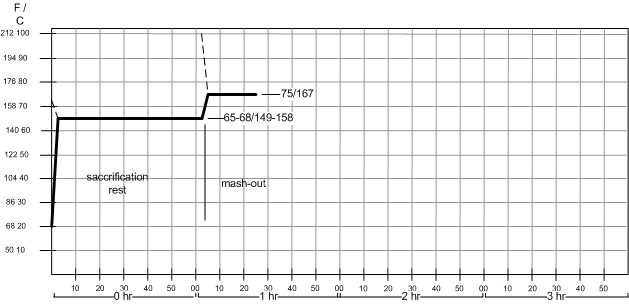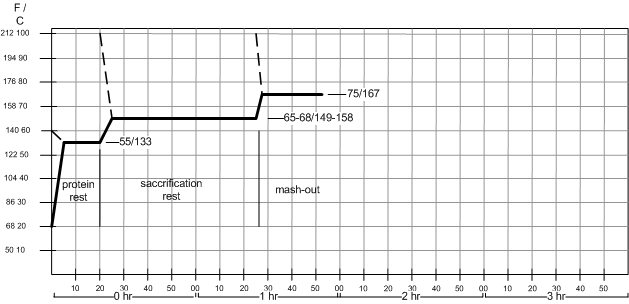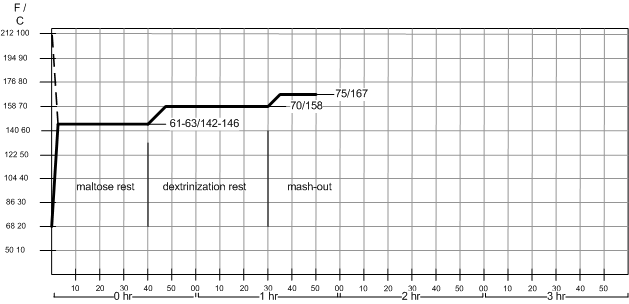Difference between revisions of "Infusion Mashing"
(→Hochkurz Mash) |
|||
| Line 80: | Line 80: | ||
The first rest (maltose rest) should be held at or around 63C (145F) and it’s length is used to control the fermentability of the wort. A good starting point for its duration is 30 min. Longer for more fermentable wort and shorter for less fermentable wort. If even higher fermentability is desired an intermediate rest at 65C (150F) can be added. Due to its large volume the mash temperature should not drop much during that rest but you may wrap the pot into blankets to stabilize the mash temp even more. | The first rest (maltose rest) should be held at or around 63C (145F) and it’s length is used to control the fermentability of the wort. A good starting point for its duration is 30 min. Longer for more fermentable wort and shorter for less fermentable wort. If even higher fermentability is desired an intermediate rest at 65C (150F) can be added. Due to its large volume the mash temperature should not drop much during that rest but you may wrap the pot into blankets to stabilize the mash temp even more. | ||
| − | The dextrinization rest at 70-72C (158- | + | The dextrinization rest at 70-72C (158-162F) needs to be held until the mash is iodine negative but may be extended to 45-60 min. Many authors contribute head retention and mouthfeel benefits to extending this rest. Finally the mash may be raised to mash out temp and subsequently lautered. |
|} | |} | ||
Latest revision as of 12:33, 21 May 2016
|
Infusion mashing is the process of achieving the rest temperatures either by adding measured amounts of water heated to carefully calculated temperatures to the mash or using direct heat to heat the mash. In a single infusion mash, the mash water is added all at once and the mash is held at a single steady temperature for the entire mash. In a step infusion mash, some of the water is held back and heated to a carefully calculated temperature before being added to the main mash to raise the temperature to each additional step. In either case, an insulated mash tun, such as a converted picnic cooler mash tun, is used to keep the temperature steady without the need for direct heat. A step infusion mash can also be accomplished with direct heat. Single temperature infusion mashThe single infusion mash uses a single temperature rest at which the beta and alpha amylase enzymes are active to convert the malt starches into wort sugars. The rest temperature controls how long the beta amylase will be active and though that the amount of fermentable sugars that are produced. The higher the mash temperature is, the lower the limit of attenuation of the resulting wort will be. This is the most common mash schedule among home brewers and craft brewers because it is well suited for American and British 2-row malts which are generally highly modified and don't benefit from a lower temperature rests. It is also well suited for the use of unheated mash tuns (e.g. coolers) which are the preferred mash vessel among most home brewers. The rest temperatures are commonly between 149 *F (65 *C) and 165 *F (69 *C). Many brewers like to use 152-154 *F (66.5-67.5*C) as their preferred mash temp as it gives a nice balance of body and fermentability that works well for British and American style ales. In order to do a single infusion mash, the strike water (water used for the mash) is heated to a certain temperature such that when the grains are mixed in, the resulting temperature is the desired rest temperature. The temperature of the strike water can be calculated with the following formula [Palmer, 2006]: Strike Water Temperature Tw = (.2/R)(T2 - T1) + T2
Hitting the mash temperature is for many brewers the biggest problem when doing a single infusion mash. This can some times lead to frustration. The reason for that is, that the above formula doesn't account for heat loss to the mash tun. It basically assumes that the mash tun has a thermal capacity of 0. To get around this one can preheat the mash tun with some boiling water or adjust the strike water temperature based on the results in previous mashes. If the latter is used the brewer should keep the mash tun and grain temperature constant between the different mashes. Another way to eliminate the unknown factor of the mash tun's thermal mass is to adjust the strike water's temperature after it has been added to the mash tun and before the grains are added. This can be done with hot and cold water. When mashing in at or above the gelatinization temperature of barley starch (between 140 and 150 *F / 60-65 *C) the grains should be added to the strike water rather than the strike water to the grains. This minimizes the formation of dough balls. Such dough balls form when the starch around them gelatenizes which provides a barrier for mash water. If they are not broken up during dough in, they can later release unconverted starches into the mash. With today's highly modified and thus enzymatic strong malts, the mash is generally converted after 15-30 min based on the rest temperature. Lower temperatures mashes convert slower than higher temp mashes of the same grist (see The Science of Mashing for further details). Most brewers do however mash 60-90 minutes since the fermentability still increases even after the wort itself is iodine negative. In addition to that longer mash times can also increase the conversion efficiency as they convert the harder to reach starch from the malt. It is always a good practice to check for conversion of the mash with a Starch Test. Though this is considered a single temperature step mash, a mash-out rest can be added. Using hot water infusions (or even decoction as shown in Decoction Mashing) the mash temperature is raised to 167 *F (75 *C). No harm is done if that temperature is not reached exactly. It should however not be exceeded. Many brewers believe that the purpose of this rest is to stop the enzymatic activity, but that is usually not the case as the alpha amylase is not fully deactivated until 176 *F (80 *C). The purpose of the mash-out is to aid lautering as hotter wort will flow more easily while still allowing enzymatic activity to convert any starches that might be unlocked during lautering [Narziss, 2005]. While this is of a lesser concern for the home brewer, a mash-out is still a good practice. Multi step infusion mashesMulti step infusion mashes refer to mashes with more than one temperature rest not counting the mash-out rest. From one step to the next the temperature is generally increased by the use of direct heat, hot water infusions or both. There are various mash rests that can be of interest for the brewer:
When direct heat is used to increase the mash temperature between the rests, the temperature should only rise 2-4 *F (1-2 *C) per minute. Going faster may risk scorching of the mash. The following is an example of a 2 step infusion mash that works well with moderately well modified German malts: It employs a short protein rest at 133 *F (55*C) and a single saccharification rest. The temperature is increased by the use of boiling water. To run as mash schedule like this, calculate the strike water temperature for your grain, a grist/water ratio of 1.25 qts/lb (~2.5 L/kg) and a rest temperature of 129-133 *F (53-55 *F). Add the water to the grain. Since the dough in happens below the gelatinization temperature of barley starch it is safe to add the water to the grain since there won't be any dough balls. There is also nothing wrong with adding the grain to the water, but it might be convenient to mill the grain directly into the mash tun. The temperature should stabilize somewhere between 122 and 133 *F (50-55 *C). If it is too close to 50, don't worry, just shorten the length of the protein rest or add some boiling water to raise the mash temp closer to 55*F. This assumes that you use fairly well modified (not overmodified) modern lager malts. Use this rest to measure and adjust the pH of the mash if you are set up to do that. The later addition of more water will not have any significant effect on this pH. While the mash is resting at the protein rest bring about 60-70% of the amount of water that you used as strike water to a boil. When the protein rest is over use a heat resistant vessel to scoop some boiling water into the mash and stir to mix it well. Measure the temperature and repeat the process until you hit the desired saccharification rest temp. This rest temp will depend on the desired attenuation of the wort and you will have to find the optimal temperature by experimenting. As a start you can use the temp that you would use for a single infusion mash. But due to the protein rest and limited beta amylase and limit dextrinase activity during that rest, the resulting wort fermentability will be higher compared to a single infusion mash at the same saccharification rest temperature. You could also use this formula to calculate the amount of water that needs to be added to raise the mash temperature [Palmer, 2006]: Wa = (T2 - T1)(0.2G + Wm)/(Tw - T2)
But the addition of boiling water until the new rest temp is reached is more reliable as it can account for factors that the above formula can't. And since the resulting mash will be quite thin, stirring it and getting the heat evenly distributed for a reliable mash temp reading is not as difficult as it is in a ticker single infusion mash. Some brewers are concerned that a thinner mash leads to more tannin extraction, but quite the opposite is true. German brewers prefer thinner mashes for delicate and lighter colored beers as it will produce more of the desirable first wort and since less sparge water needs to be used less tannins are extracted during lautering. The enzymatic activity also benefits from the changing mash thickness. A thicker mash during the protein rest enhances the protoelytic activity and a thinner mash during the saccharification rest enhances the amylase activity. If there is room left in the mash tun, mash-out can also be reached though another infusion with boiling water or through a decoction. The latter is covered in Decoction Mashing. Hochkurz MashAnother stepped infusion mash that I want to highlight here is the Hochkurz mash. There is also a decoction version of this mash which is described in the Decoction Mashing article. Here we want to focus on the infusion version of this mash schedule. Hochkurz is the combination of 2 German words: hoch means high and kurz means short. It refers to the fact that the mash doughs in at a high temperature (above protein rest temperatures) and is fairly short (less than 2 hours). The Hochkurz mash has become the standard mashing schedule for beers brewed in Germany. Especially large breweries like it because it doesn’t require decoction and can be done in less than 2 hours which fits well with their desire to be able to mash a new batch every 2 hours. It uses 2 different sacharification rests; one for each group of amylase enzymes. A low temperature rest favors the beta amylase and sets the fermentbility of the wort. A high temperature rest favors the alpha amylase and completes the starch conversion. The temperature steps necessary for this mash schedule can be achieved through infusions of boiling water or direct heat. If boiling water will be used the mash should be doughed in with a water to grist ratio of about 2.5 – 3 l/kg (1.25 – 1.5 qt/lb). Don’t be afraid of thinning out the mash through the hot water infusions. It will become easier to handle and enzymes and gelatinization also work better in a thinner mash. If direct heat is used aim for a mash thickness of 3.5 – 4.5 l/kg (1.75 – 2.25 qt/lb). This is the mash thickness that is commonly used in Germany and it makes stirring the mash during the heating phases much easier. You should also aim for a dough-in temperature that is slightly lower than the first rest temperature since it is much easier ho heat the mash than to cool it in case the first rest temperature is not hit after dough-in. The first rest (maltose rest) should be held at or around 63C (145F) and it’s length is used to control the fermentability of the wort. A good starting point for its duration is 30 min. Longer for more fermentable wort and shorter for less fermentable wort. If even higher fermentability is desired an intermediate rest at 65C (150F) can be added. Due to its large volume the mash temperature should not drop much during that rest but you may wrap the pot into blankets to stabilize the mash temp even more. The dextrinization rest at 70-72C (158-162F) needs to be held until the mash is iodine negative but may be extended to 45-60 min. Many authors contribute head retention and mouthfeel benefits to extending this rest. Finally the mash may be raised to mash out temp and subsequently lautered. |





